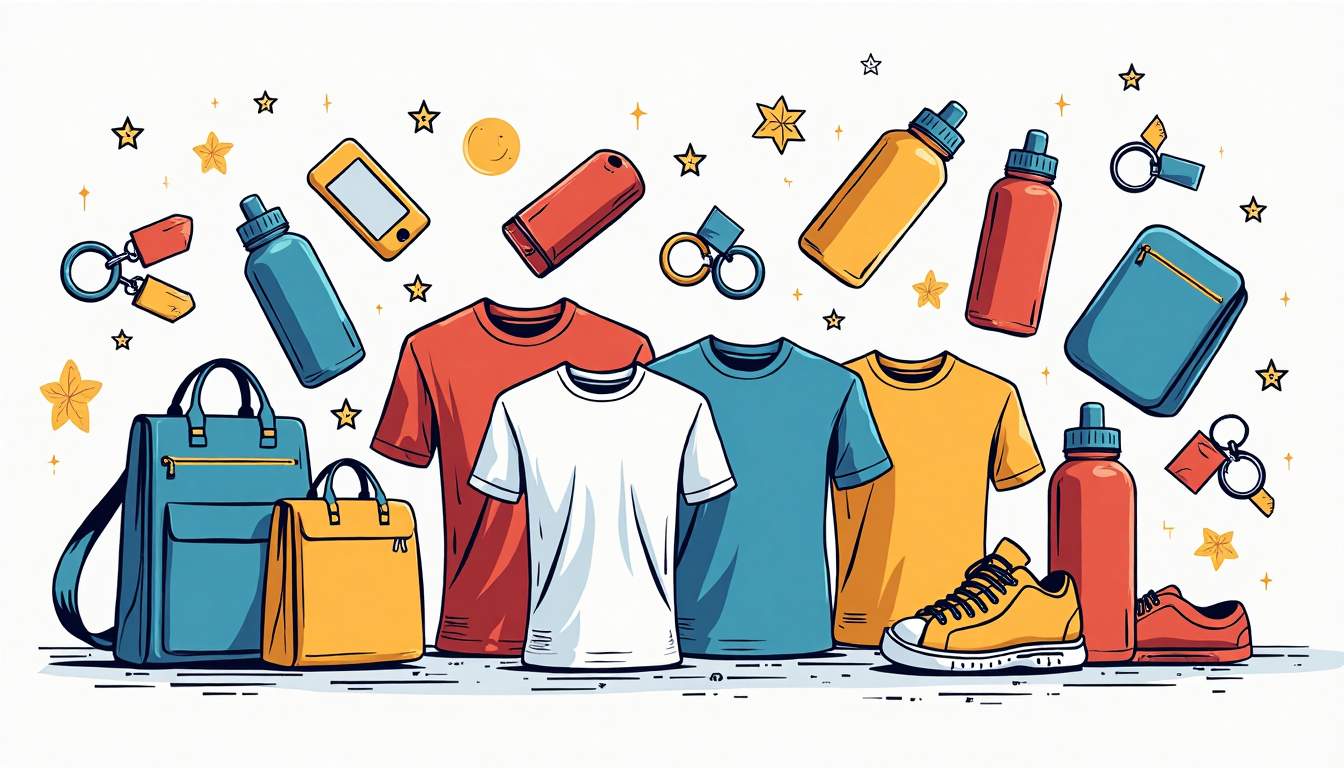more insight into our work
our company news
We only do one thing, but we do it very well. Here is where
we'll share quick updates from our
company
and special
umbrella work.

Why Use Promotional Merchandise to Boost Your Brand?
In an era dominated by screens and scrolling, a thoughtfully crafted physical item still cuts through the noise. Promotional merchandise—the branded notebook slipped into a conference tote or the insulated mug that becomes a new morning ritual—turns fleeting marketing messages into objects people can see, touch, and use. Each time the item is picked up, set down, or shown to a colleague, it generates fresh impressions that outlast a typical digital ad’s shelf life.
That staying power explains why companies of every size continue to invest in promotional products. Recent industry projections place U.S. annual sales for the sector at an impressive $27.8 billion by 2025, reflecting marketers’ confidence in the medium. When chosen and distributed strategically, branded gifts can boost brand recall, nurture customer loyalty, and drive measurable revenue—all without the skyrocketing costs often associated with other channels.
Understanding the Power of Promotional Products
Promotional items function as mobile billboards that slip effortlessly into recipients’ daily routines. Whether it’s a wireless charger on a nightstand or a tote bag riding the subway, the brand remains visible long after the initial handoff. According to WorldMetrics, 77 percent of people keep a promotional product for more than a year, granting brands months—sometimes years—of essentially free exposure.

The impact of this prolonged presence is confirmed by the numbers. Research published by Gitnux shows that 89 percent of consumers recall the company name on a promotional item they’ve received in the previous two years, while 84 percent remember the logo. For marketers chasing top-of-funnel awareness, no other single tactic offers the same combination of memory retention and cost-efficiency—especially when the average return sits at $5.65 earned for every dollar spent.
How Branded Merchandise Creates Lasting Impressions
Utility is the key to staying power. People keep items that make life easier: a notebook that organizes thoughts, a slim power bank that rescues a dead phone, or a stainless-steel bottle that keeps iced coffee cold through a morning commute. Each use reinforces brand recognition and broadcasts the brand to new audiences as the product travels from home to office to café.
Quality and relevance amplify this effect. A sustainably sourced cotton tote echoes environmental values far better than a disposable plastic key ring. Likewise, a premium metal pen communicates sophistication that a flimsy alternative simply can’t match. By aligning form, function, and brand personality, companies create a product experience that stays top of mind while elevating the perceived value of the brand. Additionally, the emotional connection forged through these thoughtfully designed items can lead to word-of-mouth referrals, as satisfied recipients share their positive experiences with friends and family, further extending the brand's reach.
The Psychology Behind Promotional Gift-Giving
Promotional gifts leverage the principle of reciprocity—receiving something of value naturally encourages people to reciprocate. That exchange doesn’t just build goodwill; it drives action. The same Gitnux study reports 83 percent of recipients are more likely to do business with the gifting brand, while 77 percent feel stronger loyalty. By offering tangible value upfront, companies transition relationships from transactional awareness to emotional affinity.
This psychological principle is further enhanced when the gifts are personalized or tailored to the recipient's interests. Items that resonate on a personal level—such as a branded yoga mat for fitness enthusiasts or a gourmet coffee blend for caffeine lovers—create a deeper connection. This not only increases the likelihood of engagement but also fosters a sense of community around the brand, as recipients feel understood and valued. The more personal the touch, the stronger the bond, making promotional products a powerful tool in cultivating long-term customer relationships.
Strategic Implementation of Promotional Items
Clarity of purpose distinguishes memorable campaigns from forgettable giveaways. A brand seeking trade-show engagement might hand out lightweight, eye-catching swag to increase booth traffic, whereas a company nurturing high-value clients could choose premium, limited-edition gifts that underscore exclusivity. Clearly defined goals ensure that product choice, messaging, and distribution channel all point in the same direction. This strategic alignment not only enhances the effectiveness of promotional items but also reinforces the brand's identity, making it more recognizable and relatable to its target audience.

Budget also shapes strategy. Premium jackets or smart speakers create few impressions but leave a powerful mark—ideal for key-account retention. Low-cost pens, stickers, or lanyards work better for mass outreach, maximizing impressions per dollar spent. Many marketers blend tiers: inexpensive items cast a wide net, while higher-value pieces deepen relationships at pivotal moments such as renewals or major milestones. This tiered approach allows brands to cater to various segments of their audience, ensuring that every interaction is meaningful and tailored to the recipient's perceived value of the brand.
Choosing the Right Products for Your Target Audience
Start with audience insights. Tech-savvy professionals gravitate toward gadgets—think cable organizers, webcam covers, or wireless chargers. Fitness-minded consumers appreciate moisture-wicking headbands or BPA-free shaker bottles. College students may prefer trendy apparel they can flaunt on campus, while senior executives respond better to leather notebooks or polished desk accessories. Promotional umbrellas, with their practical utility and ample branding space, are also a versatile choice that can appeal to a wide range of audiences, offering protection and style.
Sustainability is another critical factor. Eco-conscious recipients are more likely to keep items made of recycled or responsibly sourced materials, extending brand exposure and aligning the company with green values. WorldMetrics data notes that 65 percent of consumers keep products primarily because they find them useful, showing how practical relevance and ethical alignment turbocharge retention. Additionally, brands that prioritize sustainability in their promotional strategies often find themselves attracting a loyal customer base that values corporate responsibility, leading to increased brand advocacy and word-of-mouth referrals.
Timing and Distribution Methods for Maximum Impact
Timing amplifies engagement. Seasonally themed gifts tap into existing gift-giving moods—think branded scarves in winter or beach towels in summer. In B2B environments, sending a premium item at contract renewal transforms a routine admin task into a memorable moment. Delivery channels matter too: direct mail surprises remote prospects, QR code redemption simplifies logistics for virtual events, and in-person hand-offs spark conversation at live gatherings. Furthermore, leveraging social media platforms for distribution can create a buzz around promotional items, encouraging recipients to share their experiences and further extending the reach of the campaign.
Moreover, integrating technology into the distribution process can enhance engagement. For instance, using augmented reality (AR) to showcase how a product can be used or experienced can create a more immersive interaction. This not only captivates the audience but also provides a modern twist to traditional promotional strategies, making the brand stand out in a crowded marketplace. By combining innovative distribution methods with well-timed delivery, brands can maximize the impact of their promotional items, ensuring they are not only received but also appreciated and remembered long after the initial interaction.
Measuring ROI from Promotional Merchandise
Accurate measurement turns promotional products from a cost center into a performance channel. Begin with cost per impression: divide total spend by estimated views over the product’s lifespan. Because most items circulate for months, even a modest price tag can beat digital CPM rates. Layer on outcome-driven metrics such as leads generated, coupon redemptions, or employee-engagement scores to tie merchandise directly to revenue or productivity goals. This multifaceted approach not only quantifies the immediate impact of promotional items but also helps in understanding their long-term value, allowing brands to refine their strategies based on real-world performance.

Modern tech makes tracking straightforward. Unique QR codes, NFC chips, or personalized URLs printed on products funnel recipients to dedicated landing pages, capturing attribution at the item level. Consistent coding underscores which product types, geographies, or audiences yield the strongest lift, providing a data-driven feedback loop for future orders. Moreover, integrating these technologies with customer relationship management (CRM) systems can enhance the granularity of data collected, enabling brands to tailor their marketing efforts more effectively and create targeted campaigns that resonate with specific demographics.
Tracking Brand Awareness and Recall After Campaigns
Surveys remain the gold standard for gauging awareness. Deploy a baseline survey before distribution, then follow up four to six weeks later to measure changes in unaided and aided recall. Merchandise frequently outperforms even high-spend media buys on these metrics. Supplement survey data with social-listening to capture organic user-generated content as recipients share their gifts online—often a sign of strong brand affinity. Additionally, leveraging analytics tools can help track engagement metrics across social platforms, providing insights into how promotional items are being perceived and discussed in the digital landscape, further enhancing the understanding of brand sentiment.
Converting Merchandise Recipients into Loyal Customers
Finally, encourage action. Pair the gift with a limited-time offer or VIP access code to convert immediate interest. Then nurture long-term engagement through email sequences or loyalty programs: tips for caring for a water-resistant jacket, recipe ideas for a branded blender bottle, or sneak peeks at new releases. These touchpoints build an ongoing relationship, transforming a single giveaway into a lasting growth engine for the brand. Furthermore, consider creating exclusive online communities or forums where recipients can share their experiences and ideas related to the merchandise. This not only fosters a sense of belonging but also encourages word-of-mouth marketing, as satisfied customers become brand advocates, sharing their positive experiences with friends and family, thereby amplifying the reach of your promotional efforts.